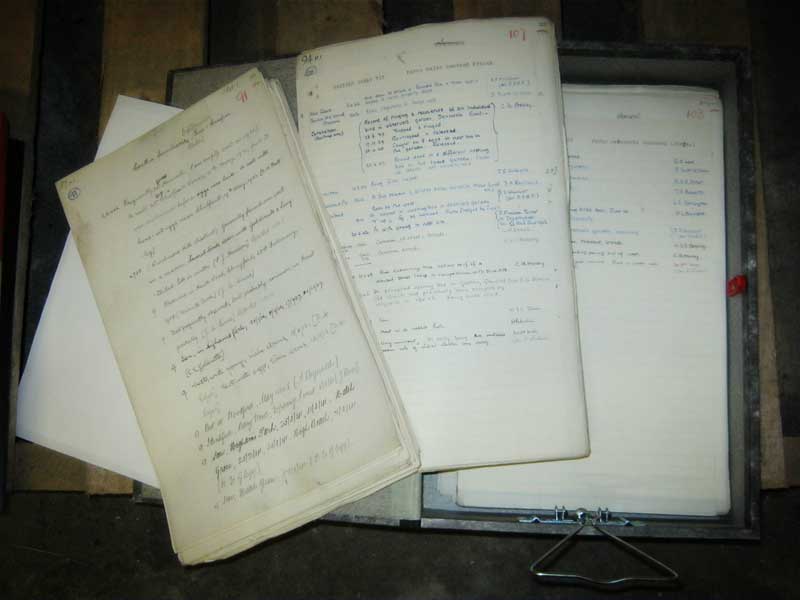David Allen, GiGL Volunteer

Foolscap paper records from LNHS files © David Allen
In 2011, I wrote about my involvement with the ornithology records of the London Natural History Society, noting that I had first crossed their path some twenty years before that. Five years on, the nature of the project has changed, but much of the original challenge remains.
I had seen my role, offering services to GiGL to process some old data, as not too demanding. However, when space in the Union Street offices reached saturation point, Union Street turned into a redevelopment hot spot (thanks to David Beckham and Gordon Ramsay) and GiGL had to move along with London Wildlife Trust, I discovered that, somehow, LNHS’s ornithology records were considered my responsibility. The only solution I could think of was to take a deep breath and commit the records to cyberspace. A quick round of office records management firms produced DA Archive Solutions in Melksham, who collected the records, scanned them, and disposed of the evidence, all for a very reasonable fee, much to the relief of the LNHS Treasurer who had to stump up. One box of errant records had to be rescued from the wormhole in space into which it had fallen, but this was retrieved during the office clearance and sent off to be dealt with in the same manner. As a result of this exercise, we had precisely 64,057 images of record cards or record sheets, with data from 1900 to 1987.
While transcribing these records and including them in GiGL’s Recorder database was the ultimate aim, I could see that the information stored in these images could be made available for use by indexing each image by year, species and vice-county; the information architecture which had been created for the card system. This could be completed much more quickly than transcription and would make the data accessible more quickly. I spent a couple of years indexing the 1951 to 1987 cards which were used as the basis for writing the annual London Bird Reports, and the 1900 to 1950 cards which were used for the 1957 publication of “Birds of the London Area” in the “New Naturalist” series.
If I had thought through this project and planned it carefully I would have wanted to make sure that the cards were all properly in order before scanning. Theoretically, with a firm grasp of the systematic order of bird species in Witherby’s “Handbook of British Birds” you could then find your way through the cards unindexed. Indeed it was obvious from the packets of misfiled cards, and cards excerpted from the main sequences, that that was exactly what had happened before, over the years, as the cards were used for various projects. In reality, that physical check would have been impractical in the time available. It has proved very much quicker to index the cards, wherever they are in the sequence, from the scans.
No good deed goes unpunished however and Mark Spencer, LNHS’s botany recorder, drew my attention to the historical botany record cards, blessedly only nine boxes rather than whole cabinets. DA Archive Solutions and the LNHS Treasurer sprang into action again, resulting in another six thousand or so images. In indexing these, as I am at the moment, I must say that I regret ever saying a cross word about the bird records. Byzantine changes in taxonomy and nomenclature, and a list of species weird beyond the imagination of any birder (some of which were found growing on the compost heap next to the Kew Herbarium) together with a propensity on the part of those species to hybridise beyond the bounds of decency, make for an interesting index list. The cards relate to Rodney Burton’s “Flora of the London Area” published in 1983, with some later additions and some data which was excluded from the flora. At least with plants, when records are assigned to a particular vice-county one can be reasonably sure they are not heading at sixty miles an hour for the next, as has all too obviously happened with some of the birds.
For both botany and ornithology, the importance of systematic storage of records in an organised database like Recorder is indisputable. But the visual records that accompany the record cards have a value of their own – they are more than a staging post on the way to a database. Letters, drawings and maps are all included in the index, as well as narrative information and recorders’ comments, which can be sidelined in a database. Better still, the records can be disseminated for use, making access much easier and quicker.
The botany records have to be finished, the work of another few months. Next up for indexing are the images of bird records on foolscap sheets from 1908 to 1943, and the series of miscellaneous cards and documents accumulated over the twentieth century. All of this is achievable relatively quickly and easily. The next stage will be to organise some sort of crowdsourcing for transcribing these card images so that individual records can be accessed via the Recorder database. Crowdsourcing seems to be the only practical option for such a large dataset.
